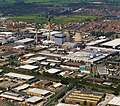Portal:Berkshire
Welcome to the Berkshire portal

The Royal County of Berkshire, commonly known as simply Berkshire (/ˈbɑːrkʃɪər, -ʃər/ ⓘ BARK-sheer, -shər; abbreviated Berks.), is a ceremonial county in South East England. It is bordered by Oxfordshire to the north, Buckinghamshire to the north-east, Greater London to the east, Surrey to the south-east, Hampshire to the south, and Wiltshire to the west. Reading is the largest settlement and the county town.
The county has an area of 1,263 km2 (488 sq mi) and a population of 911,403. The latter is concentrated in the east, the area closest to Greater London, and includes the county's largest towns: Reading (174,224) Slough (164,793), Bracknell (113,205), and Maidenhead (70,374). The west is rural, and its largest town is Newbury (33,841). For local government purposes Berkshire comprises six unitary authority areas: Bracknell Forest, Reading, Slough, West Berkshire, Windsor and Maidenhead, and Wokingham. The historic county included the parts of Oxfordshire south of the River Thames, which formed its northern border, but excluded Caversham and Slough.
The Berkshire Downs, a chalk downland and area of outstanding natural beauty, occupy the west of the county. They are the source of the River Kennet, which flows east through Newbury before meeting the Thames at Reading. The Thames then forms Berkshire's northern border, flowing past Maidenhead, before entering the county and flowing past Slough and Windsor. The south-east of the county contains Swinley Forest, a remnant of Windsor Forest now used as a forestry plantation.
There is evidence of prehistoric settlement on the Berkshire Downs, including the Iron Age Uffington White Horse, now in Oxfordshire. In the Anglo-Saxon period the region was contested by Mercia and Wessex, and Alfred the Great was born in Wantage, also now in Oxfordshire. Windsor Castle, which would become the official country residence of the British monarch, was built after the Norman Conquest. The county has been the site of several battles, particularly during the First English Civil War, when Reading and Wallingford were besieged two battles took place at Newbury, in 1643 and 1644. The proximity of the east of the county to London led to development from the nineteenth century, when Slough became an industrial centre and Bracknell was designated a new town. Software development and high-tech industry dominate the economy in the east, but the west remains an agricultural region. (Full article...)
Selected article

In England, Sites of Special Scientific Interest (SSSIs) are designated by Natural England, which is responsible for protecting England's natural environment. Designation as an SSSI gives legal protection to the most important wildlife and geological sites.
Berkshire lies in the valleys of the Thames and its tributary, the River Kennet, and in the west it is crossed by chalk hills. It has a population of more than 860,000. It is no longer an administrative county following the abolition of Berkshire County Council in 1998. It is governed by six unitary authorities: Bracknell Forest, Reading, Slough, West Berkshire, Windsor and Maidenhead and Wokingham.
As of September 2019, there are 70 SSSIs in Berkshire, of which 8 are listed for their geological interest and 62 for their biological interest. Eight are Geological Conservation Review sites, three are Nature Conservation Review sites, two are Ramsar sites, five are Special Areas of Conservation, five are Special Protection Areas, five are Local nature reserves, one is listed on the Register of Historic Parks and Gardens and two contain Scheduled monuments. Fifteen sites are managed by Berkshire, Buckinghamshire and Oxfordshire Wildlife Trust, one by Surrey Wildlife Trust and three by the National Trust.
(Full article...)
Selected biographyCharlton Brooker (born 3 March 1971) is an English writer, television presenter, producer and satirist. He is the creator and co-showrunner of the sci-fi drama anthology series Black Mirror, and has written for comedy series such as Brass Eye, The 11 O'Clock Show, and Nathan Barley. Brooker started his career as a cartoonist; he produced adverts for the second-hand video game retailer CeX before becoming a journalist for PC Zone. He has presented a number of television shows, mostly consisting of satirical and biting criticism of modern society and the media, such as Screenwipe, Gameswipe, Newswipe, Weekly Wipe, and 10 O'Clock Live. He also wrote the 2008 horror drama series Dead Set. He has written social criticism pieces for The Guardian and is one of four creative directors of the production company Zeppotron. (Full article...) TopicsHistory: Battle of Reading (871) • Battle of Reading (1688) • First Battle of Newbury • Second Battle of Newbury • Siege of Reading Selected picturesDid you know
CategoriesRelated portalsWikiProjectsWikimediaThe following Wikimedia Foundation sister projects provide more on this subject:
Discover Wikipedia using portals |


































